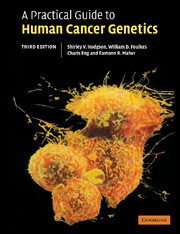Book contents
- Frontmatter
- Contents
- Dedication
- Preface
- Acknowledgements
- Part one Cancer genetic counselling
- Part two Genetics of human cancers by site of origin
- 2 Central nervous system
- 3 Eye
- 4 Cardiorespiratory system and thorax
- 5 Endocrine system
- 6 Gastrointestinal system
- 7 Reproductive system
- 8 Urinary system
- 9 Blood and lymph
- 10 Musculoskeletal system
- 11 Skin
- Part three Cancer-predisposing syndromes
- Appendix
- References
- Index
4 - Cardiorespiratory system and thorax
Published online by Cambridge University Press: 20 August 2009
- Frontmatter
- Contents
- Dedication
- Preface
- Acknowledgements
- Part one Cancer genetic counselling
- Part two Genetics of human cancers by site of origin
- 2 Central nervous system
- 3 Eye
- 4 Cardiorespiratory system and thorax
- 5 Endocrine system
- 6 Gastrointestinal system
- 7 Reproductive system
- 8 Urinary system
- 9 Blood and lymph
- 10 Musculoskeletal system
- 11 Skin
- Part three Cancer-predisposing syndromes
- Appendix
- References
- Index
Summary
Head and neck cancer
General
Squamous carcinomas of the head and neck (a grouping which includes tongue and mouth, nasopharynx and larynx) are associated with cigarette smoking and alcohol ingestion (although the risk factors for different sites may differ). In addition, specific head and neck cancers may be associated with familial cancer syndromes such as hereditary non-polyposis colon cancer syndrome and Li–Fraumeni syndrome (larynx) and Fanconi anaemia (oral cancer). Foulkes et al. (1996) reported a relative risk of 3.7 for developing head and neck cancer in first-degree relatives of an affected case, but the relative risk was almost 8 if the index case had multiple primaries. Spitz et al. (1994) reported an association between mutagen susceptibility (bleomycin-induced chromosome breakage) and multiple primary head and neck cancers, and while new data from the Spitz group (Wu et al., 2002) and others (Cloos et al., 2000) have confirmed or extended these findings, some researchers have questioned the significance of these observations (Szekely et al., 2003), and the bleomycin sensitivity assay is not used clinically. Interestingly, IGF-1 levels also predict the risk of second primary head and neck cancers, and such an assay could be clinically useful (Wu et al., 2004).
Specific sites
Nasopharynx
Cancers of the nasopharynx account for 0.1 per cent of all cancers, and differ from tumours in other parts of the pharynx by not being associated with tobacco or alcohol.
- Type
- Chapter
- Information
- A Practical Guide to Human Cancer Genetics , pp. 28 - 32Publisher: Cambridge University PressPrint publication year: 2006

